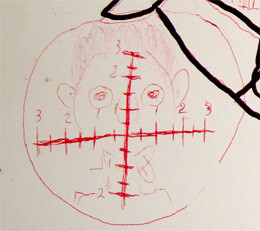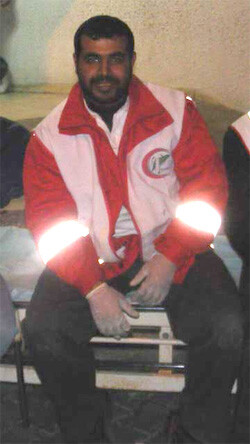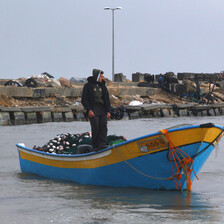Gaza Strip 21 January 2009
20 January 2009

Graffiti left by Israeli soldiers in a house they occupied in Ezbet Abed Rabu, eastern Jabaliya.
Even today, after mentioning to the Canadian TV crew accompanying me that fire blobs had burned up ‘til yesterday, we found still more blobs spread out, smoldering and willingly breaking into white smoking fires anew. I have seen this often enough now. They were impressed by it, by the fact that it’s now eight days after the fire and the blobs are still simmering, smoldering, ready to flame up.
The Red Crescent team of the north of Gaza had gathered at the Ezbet Abed Rabu station, to cut swathes of transparent plastic into lengths to be further cut to fit glass-less windows, blown out in the bombings on and around the houses. This is the first step in providing some immediate relief from the cold. For the homeless, however, I don’t know what will be offered, or if tents are available.
In the next few hours, I was able to meet another extended family, take their testimonies that included the shelling of their house, phosphorus-like fires, sadistic drawings left behind by the Israeli soldiers occupying the house, the imprisonment of the elderly parents for four days with no food, no water, no toilets, no medicines, and the killing of their sheep and goats. The mother was terrified, and thanked me in a stream of frightened babble intermixed with gratitude for listening. “We saw terrible things, terrible things,” she said. “They’ve come three times, and this was by far the worst ever. I saw dead bodies on the streets. We are just an old man and woman; why did they do this to us?” The medicine and insulin that she should have been taking lay in the dirt, stepped on, where they were thrown by soldiers who took the couple from their one-room house to a room of their sons’ house. The older man pulled an inhaler out of his breast pocket, saying that this too was denied to him during his imprisonment.
I also returned to the home of my friends, to take the testimony of Abu N. who I’d worried so much about. Two days ago when I’d first seen him again, after nearly three weeks of wondering if he was still alive, he was pale, sallow, nervous, and looked defeated. Yesterday, too, he looked weak, less the proud elderly man he’d been before. Today, I was gratified to see much of his former self returning, despite his ordeal, despite the killing of his wife. He and one son chuckled as they vied for conversation time, his English returning only in bits but his determination to practice it returning in waves. Seeing the two, so crushed by the loss of Umm N., returning to life was inspiring.
Rudely, I left before a meal, though all insisted I stay. Normally, I would not turn it down, particularly after they had just begun to get their house into less of a disaster state: feces cleaned up from where the occupying soldiers had strewn it, all over the house; bags of soldiers’ filthy leavings taken out; soldier-soiled clothing gathered, bagged, and burned; and the many shattered dishes and broken items cleared out. It is barer, and there are so many new holes from the bullets and tank shells. The indescribable, terrible, stench still lingers, that of an army which occupied the house for two weeks and left shit and unknown foul smells throughout the house. It is a stench I’ve smelled in other houses in the area occupied by the Israeli army.

Arafa Abd al-Dayem, killed in 4 January while trying to recover a wounded person and a corpse.
Fourteen days after his murder, the family was finally able to begin the three-day mourning process. I visited them on the last day, unaware until today that it was happening. I found his widow as expected, grieving painfully and lamenting the loss of a kind man, good husband and loving father. After seeing bodies in many states of injury, near death, and savagely-rendered death, I found that I am still able to cry. While the horrors of Israel’s continual bombing, I’d become surprisingly immune to shock or fear from the noise or notion of being hit, and even to death. But just looking into Arafa’s widow’s eyes, seeing her pain and remembering my own pain at losing him, my emotions proved to be intact still, meaning that a lot will surface later, in quieter times.
And this realization leads to the subsequent realization that so many Palestinians don’t really have a means of addressing: their pain and psychological scarring — particularly as so many have repeatedly endured invasions, as well as other emotionally-damaging things like living under military occupation, being imprisoned or having family members imprisoned, and living under siege and in closed borders, to name but some.
Abdallah, one of Abu N.’s grandchildren, cries pretty much all of the time I see him now. He was a bit of a cheeky six-year-old when I first met him two months ago. Now he seems stuck in his memories of bomb explosions and drone sounds. The drones I can identify with: even now, near midnight on 20 January, two days into the ceasefire, the drones circle. The very distinct noise the drones here make is not a noise I can disassociate from the three weeks of precise bombardment and death which accompanied it. And very likely Abdallah won’t get any sort of therapy for this, although his family is compassionate, and he will have to carry this baggage along with future baggage, as will the majority of those here. The most visible aspects of this war on Gaza are the massive craters, the demolished houses and buildings in every direction, in every town and city, the burnt-out warehouses and shops and hospital rooms and schools and cars, and the amputated limbs, the burned skin, the still-burning fires. But those very deep emotional injuries are what were intended to cripple society even more than physical damage.
Eva Bartlett is a Canadian human rights advocate and freelancer who spent eight months in 2007 living in West Bank communities and four months in Cairo and at the Rafah crossing. She is currently based in the Gaza Strip after having arrived with the third Free Gaza Movement boat in November. She has been working with the International Solidarity Movement in Gaza, accompanying ambulances while witnessing and documenting the ongoing Israeli air strikes and ground invasion of the Gaza Strip.
Related Links





